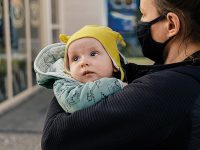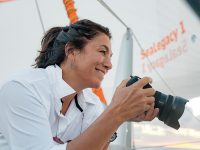Saving the pharmacy of the sea
How does global change affect species with bioactive potential in the Mediterranean?
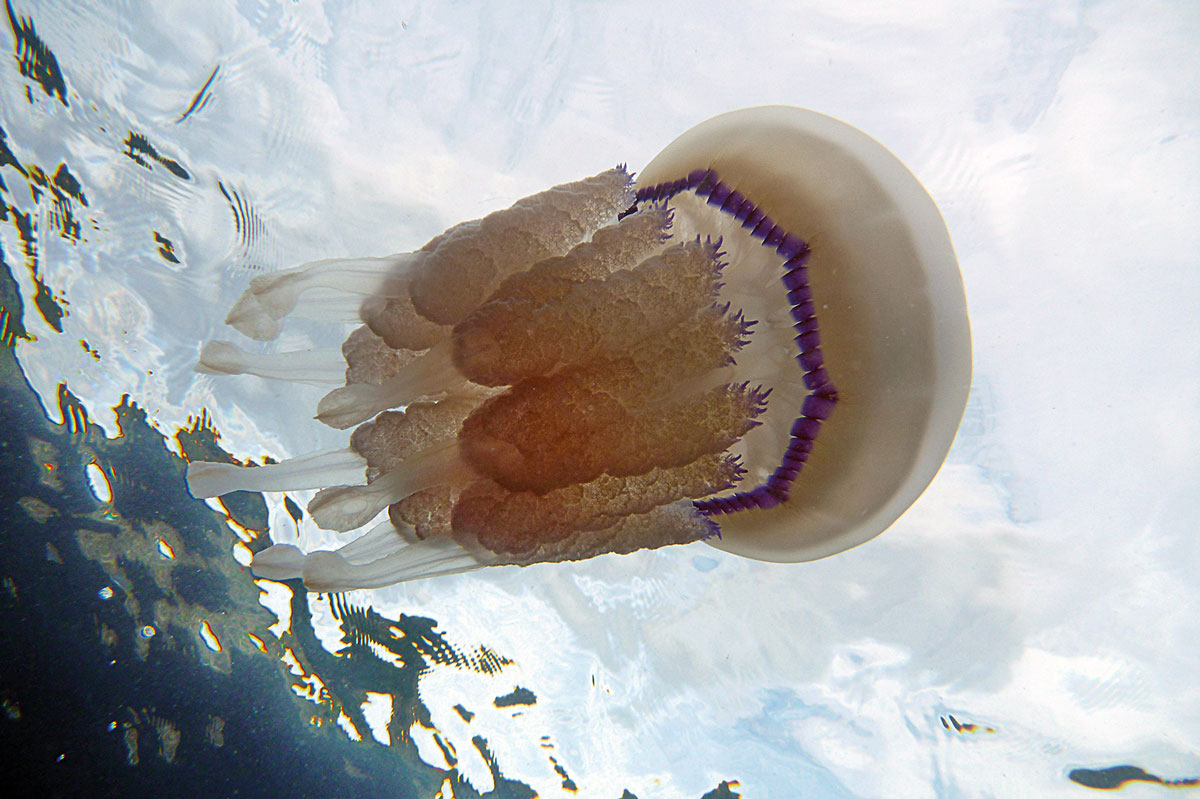
Several marine species in the Mediterranean produce molecules with bioactive potential that could be used to develop new drugs (antibiotics, antifungals, antivirals, and antitumourals). Different human activities such as pollution, marine recreation, and fishing, as well as climate change, threaten and even endanger some of these species. These vulnerable species with bioactive potential must be protected, especially in marine reserves, not only because they are valuable components of marine ecosystems, but also because they are a potential source of molecules with pharmacological properties that are currently being researched for the creation of new drugs.
Keywords: global change, oceans, biodiversity, health, bioactive compounds.
Introduction
Marine organisms, which account for nearly two million species, establish highly competitive and complex relationships, often in space-constrained habitats that force them to compete very aggressively (Simmons et al., 2005). In response to this competition, many species produce chemical compounds, often called bioactive compounds, for several purposes: to defend themselves from predators, protect themselves from the expansion of other competing species, or capture their prey (Simmons et al., 2005). Bioactive compounds are molecules produced by a wide variety of organisms which, in the case of marine organisms, can range from bacteria, fungi, and microalgae to more complex organisms such as macroalgae, marine phanerogams, invertebrates, and vertebrates. These compounds include a wide range of molecules that are currently being researched to synthesize new products and medicines; they include anti-cancer peptides, characterised by their cytotoxic (cell damaging) and anti-tumour action (antiproliferative function, among other properties) against various tumour cell lines. These represent antibacterial, antifungal, and antiviral metabolites that can be used to make antibiotic, antifungal, and antiviral drugs, respectively. Some of them are antioxidant molecules that can protect cells from reactive oxygen species and free radicals, and others are anti-inflammatories, which can help combat some inflammatory cellular processes leading to certain diseases. They also include toxins and antitoxins, which can have various therapeutic uses, as well as complex natural products such as essential oils (Carreño & Lloret, in press; Uriz et al., 1991).
«Several species in the Mediterranean are potential sources of molecules with pharmacological properties»
Several animal and plant species in the Mediterranean Sea have bioactive potential (Uriz et al., 1991), i.e., they are a potential source of molecules with pharmacological properties that could be used to develop new antibiotic, antifungal, antiviral, or antitumour drugs. Most are sessile benthic organisms that produce molecules with bioactive potential, such as the tunicates Ecteinascidia turbinata and Halocynthia papillosa, which have anti-tumour potential; sponges such as Spongia officinalis and Axinella damicornis, with antibacterial potential; bryozoans such as Myriapora truncata and Pentapora fascialis, which also have antibacterial potential; and cnidarians such as Pennatula aculeata and Actinia equina, with anti-inflammatory potential. Some echinoderms such as the sea urchin Paracentrotus lividus and the sea cucumber Holothuria tubulosa, have both anti-inflammatory potential and produce bioactive compounds; molluscs such as the cuttlefish Sepia officinalis and squid Loligo vulgaris, have antibacterial potential; decapod crustaceans such as the Norway lobster (Nephrops norvegicus) and the Mediterranean green crab (Carcinus mediterraneus), have anti-tumour potential; and fish such as sardines (Sardina pilchardus) and the Thornback ray (Raja clavata), make compounds with antioxidant potential. All these animals produce a wide variety of chemical compounds that serve to defend them against their predators, competing organisms, parasites, or invasive micro-organisms (Carreño & Lloret, in press; Uriz et al., 1991).
«Despite interest in their compounds with bioactive potential, some of these species are threatened and endangered»
Despite interest in these compounds with bioactive potential for the development of future medicines, these species are also affected by climate change and human activities, and some are even threatened and endangered. Despite the critical status of some of them, studies on the impact of anthropogenic activity on their conservation status are still scarce. Thus, further studies are needed to better understand how these species cope with the impact of human activities and climate change, because if they become extinct, the possibilities these species might offer in the discovery of new medicines of marine origin will be lost too.
The impact of global change on species with bioactive potential

Figure 1. Mediterranean species with bioactive potential classified as vulnerable and ordered according to their vulnerability index, based on a study carried out in the Natural Park of Cap de Creus by Carreño and Lloret (in press). Blank lines correspond to species classified as vulnerable according to the criteria established in the methodology of this article, but no information on their vulnerability index was provided.
Several studies have analysed the role of species with bioactive compounds in the Mediterranean in recent years. In 2019, a review of fish and macroinvertebrate species with bioactive potential described in the scientific literature (Carreño & Lloret, in press) was carried out in the marine reserve of Cap de Creus (in northern Catalonia). They assessed vulnerability using the methodological framework established by Lloret et al. (2019), considering species that appeared on the IUCN Red List/Mediterranean Regional Assessment as threatened or in a higher threat category, and those with a vulnerability index (VI) above 60 (i.e., high to very high vulnerability, according to the index established by Cheung, Pitcher, and Pauly [2005]). Species listed in different international conventions for the protection of flora and fauna in Barcelona, Bern, or CITES, as well as in the EU Habitats Directive, were also included.
After reviewing the scientific literature[1] for information on the anthropogenic and climate change impacts on these fish and macroinvertebrate species, and reviewing studies from grey literature and research projects, we established that 32 species with bioactive potential are vulnerable and threatened by different anthropogenic factors such as pollution, marine recreation, and fishing, as well as by the action of climate change. Even though some of these species have not been sufficiently studied and so their vulnerability index is unknown, they are listed as vulnerable in the IUCN Red List or have been included in international protection conventions (Figure 1). Among these species, sponges and chondrichthyan fishes are particularly vulnerable.
Marine pollution
Marine pollution (plastics, waste, sewage, etc.) affects all marine organisms, but is particularly harmful to sessile and slow-growing organisms such as some sponges, ascidians, cnidarians, and bivalves, which include many species that produce molecules with bioactive potential. Consequently, their growth and filtration capacity are limited (Zahn et al., 1977).
Waste can pollute in several ways: it can accumulate on the surface of species and inhibit their growth and cause damage such as tissue necrosis, strangulation, asphyxiation, etc. Plastics are the main source of marine pollution and rubbish, representing up to 80 % of all human-generated waste in the Mediterranean (Derraik, 2002). Plastics can also accumulate in filtering organisms or be broken down into microplastics that can be ingested by other organisms and bioaccumulate through the food chain until they reach humans (Bordbar et al., 2018). Although microplastics have been found in fish that produce molecules with antioxidant and anti-tumour potential such as mackerel (Scomber scombrus) or bluefin tuna (Thunnus thynnus), the effects on human health are still poorly understood.
«32 species with bioactive potential in the Mediterranean Sea are vulnerable and threatened by different anthropogenic factors»
The sewage that some boats still dump into the sea promotes the proliferation of toxic micro-organisms and micro-algae, which limits the exchange of oxygen in the water and leads to local anoxia. It also affects the quality of the water, because proliferation of these organisms – which take advantage of the excess organic matter in wastewater – releases large amounts of H2S and CO2. For example, there are areas in the Bay of Palma (Majorca, Spain) where algae and marine phanerogams that may have bioactive potential – such as Posidonia oceanica, which contains compounds with anti-inflammatory potential – do not grow. This problem may be because of the city’s wastewater discharges which might be hindering photosynthesis of Posidonia species. This is because, in addition to water clouding caused by particles in this wastewater, this sewage also promotes algae growth as a result of the increased presence of nutrients (Bonin-Font et al., 2018). In addition, chemicals such as industrial fats, detergents, and soaps can also cause alterations in the phytoplankton (which constitutes the basis of the food chain), obstructing the filtering capacity of organisms with bioactive potential such as certain gorgonians, corals, sponges, ascidians, and bivalves, thus causing these organisms to die (Zahn et al., 1977).
Marine recreational activities
Motorboats and jet skis operating on shallow sandy or muddy seabeds can contribute to the generation of suspended sediments, which significantly increases water turbidity and decreases light penetration. This can cause adverse effects on algae, marine phanerogams, and other sessile animal species with bioactive potential. Suspended sediments can also directly affect certain fish that produce compounds with bioactive potential, such as the Atlantic bonito (Sarda sarda) and white horse mackerel (Trachurus mediterraneus) – both of which contain compounds with antioxidant potential – by reducing both the availability and visibility of nutrients, or by obstructing the gills of these organisms (Bruton, 1985). Turbidity not only affects water transparency, but also favours its eutrophication, which can promote the proliferation of toxic bacteria and harmful algae due to the increased presence of decomposing organic matter (Alexander & Wigart, 2013). These harmful organisms can pose a threat to both marine species and the health of humans visiting these areas.
«Marine pollution is particularly harmful to sessile and slow-growing organisms»
Commercial and leisure sailing in some busy areas causes ongoing noise levels that can affect the marine fauna (including birds and mammals), leading to changes in their behaviour (Codarin et al., 2009). The noise from engines can affect certain fish that may have bioactive potential. For example, the noise from boats reduces the hearing sensitivity and ability to communicate of the brown meagre (Sciaena umbra) – a fish which makes compounds with anticoagulant potential (Codarin et al., 2009).
The impacts of ship anchors and chains can also damage several algae, marine phanerogams, and sessile benthic species, especially those that are slow growing and are more sensitive to pollution (Milazzo et al., 2004; Natalotto et al., 2015). From among these, Mediterranean noble pen shell (Pinna nobilis), which produces compounds with antioxidant potential stands out; this bivalve is currently in critical danger of extinction because of several natural and anthropogenic factors. On the one hand, its survival is threatened by the anchoring of recreational boats (Hendriks et al., 2013) and marine pollution (Natalotto et al., 2015), and on the other hand, because of high mortality caused by a recent disease attributed to the endoparasite protozoan Haplosporidium pinnae (Cabanellas-Reboredo et al., 2019).

There are several animal species that produce compounds with bioactive potential in the Mediterranean Sea including molluscs such as cuttlefish (Sepia officinalis), with antibacterial potential (on the left), or echinoderms such as the sea urchins (Paracentrotus lividus), with anti-inflammatory potential (on the right). / Photo: Lluís Mas Blanch – Revital Salomon
However, sessile organisms with bioactive potential are not only affected by boats; other leisure activities that can involve contact with the benthos, such as underwater fishing or diving, can also sometimes impact these organisms. This is the case of the bryozoan Pentapora fascialis (with antibacterial potential), which is damaged by impacts from the flippers of inexperienced divers and underwater fishermen (Casoli et al., 2017).
Fishing
Some professional fishing methods, such as trawling, dramatically affect marine habitats and species (Pipitone et al., 2000). Many types of fish are not targeted by fishing activity because they have little or no commercial value) and so these are usually part of discards. Nonetheless, several of these have bioactive potential, including the greater pipefish Syngnathus acus and greater weever Trachinus draco, with cytotoxic and anti-tumour potential, respectively.
«Not only boats affect sessile organisms with bioactive potential; other activities such as fishing, or diving can also impact them»
Also of note are several species which produce molecules with anti-tumour potential such as tuna, smooth-hound (Mustelus mustelus), basking shark (Cetorhinus maximus), and common stingray (Dasyatis pastinaca) – all of which are on the IUCN Red List and are included in several international conventions for the protection of fauna such as CITES (Barcelona) and Bern.

The impacts of ship anchors and chains can also damage many algae, marine phanerogams, and sessile benthic organisms, especially those that are slow growing and which are more sensitive to pollution. / Photo: Josep Lloret
On the other hand, fish populations with bioactive potential are threatened not only by the action of large-scale commercial fishing, but sometimes also by small-scale and recreational fishing (Lloret et al., 2019), as is the case of the dusky grouper (Epinephelus marginatus), gilt-head bream (Sparus aurata), and common dentex (Dentex dentex): species that all produce molecules with antibacterial potential (Lloret et al., 2019). The skin of blue sharks (Prionace glauca) has antioxidant properties, but it is also one of the most commercially exploited shark species in surface longlining and by some recreational fishermen. The blue shark is listed in the IUCN Red List as globally threatened, but its population is especially declining in the Mediterranean where it is currently classified as «critically endangered». Although recreational fishermen in Spain are not allowed to fish for it, they are also not required to report their catch. Therefore, the overall impact of recreational fishing on sharks is difficult to quantify (Lloret et al., 2019).
Finally, the operation of fishing gear causes a lot of damage to sessile species (gorgonians, for example) through abrasion, strangulation, etc. Vagile species are also affected by «ghost» fishing, caused by fishing gear lost at the bottom of the sea that continues to catch fish (Lloret et al., 2014) and thus, constitutes a threat to these species with bioactive potential.
Warmer waters
It is a well-known fact that the temperature of seawater in the Mediterranean has increased as a result of climate change, and that this warming is negatively affecting the growth and survival of sessile species with bioactive potential such as the gorgonian Paramuricea clavata and red coral (Corallium rubrum) (Verdura et al., 2019).
«Several species with bioactive potential are vulnerable to global change»
Warming of marine waters can also lead to massive species mortality because of the proliferation of opportunistic thermophilic pathogens (Trainer & Hardy, 2015). Algae proliferations are increasingly common, and these can both release toxic substances that directly induce mortality among fish, crustaceans, and mollusc species, and cause anoxia in shallow seas such as the Mar Menor, thereby causing significant ecological impacts (Erena et al., 2019). The latter example is not only caused by warming of the ocean, but also by the sudden supply of nutrients from rivers during periods of intense rain, which favours the proliferation of microorganisms in these shallow waters.
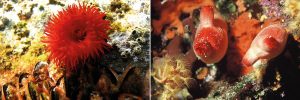
Some animal species in the Mediterranean are potential sources of molecules with pharmacological properties that could be used to research new drugs. Most are sessile, benthic organisms like the ones in the pictures. On the left, the cnidarian Actinia equina, with anti-inflammatory potential; on the right, the tunicate Halocynthia papillosa, with anti-tumoural potential. / Photo: Toni Font – Albert Kok
Finally, the increase in sea temperature can also displace species with bioactive potential into colder waters, as in the case of sardines (Sardina pilchardus) and mackerel, while encouraging the appearance of thermophilic species, which can sometimes be invasive (Katsanevakis et al., 2014) or even dangerous to human health. A good example is the silver-cheeked pufferfish Lagocephalus sceleratus, which is expanding into the Mediterranean (especially on the eastern shores) from the Red Sea through the Suez Canal, aided by increased sea water temperatures. Besides being invasive and disrupting the food web in the new areas in which it has established itself (Coro et al., 2018), this species is poisonous and produces a potentially fatal toxin, tetrodotoxin (TTX), which causes paralysis and death to those who ingest it (Nieto et al., 2012). Therefore, the Suez Canal represents an added problem to the already complicated management of water warming because it is the source of a constant influx of new species (an estimated 700 and 1,000 invasive species) into the Mediterranean. In addition to pufferfish, other invasive and potentially dangerous organisms that have been introduced into the ecosystem via the Suez Canal are red lionfish (Pterois volitans) and several species of toxic jellyfish such as Rhopilema nomadica.
In contrast, warming waters also threaten the survival of native species which produce bioactive compounds that may be useful against emerging and highly topical diseases. For example, a drug called Aplidin has been derived from the sea squirt Aplidium albicans which is currently being used to combat some types of myeloma (cancer) and is also being studied as a possible treatment for COVID-19 (PharmaMar, 2020). Thus, there is an urgent need to protect species with bioactive potential that can provide effective medicines to combat new diseases.
While the increase in sea water temperature appears to have been detrimental to these species with bioactive potential, this warming could also potentially provide opportunities for thermophilic species that can benefit from the increase in sea temperature and may also produce compounds with bioactive potential. Examples include the round sardinella (Sardinella aurita), a species that has antioxidant potential, and cuttlefish (Sepia pharaonis), which have a cytotoxic potential. Moreover, tetrodotoxin extracted from the invasive pufferfish Lagocephalus sceleratus is now being used in the synthesis of new analgesic medicines to alleviate chronic pain (Nieto et al., 2012) and venom from Scorpaena plumieri (Campos et al., 2016) contains both inflammatory and cytotoxic bioactive compounds. The heating of the waters also favours the proliferation of algae and microorganisms that can produce toxins with bioactive potential, including the dinoflagellate Karenia brevis in the Gulf of Mexico, which is currently being examined because it may provide a new medicine to treat cystic fibrosis (Potera, 2007). Warmer waters may also be contributing to an increase in jellyfish populations (Boero et al., 2016), among which some, like Rhizostoma pulmo and Pelagia noctiluca, have cytotoxic bioactive potentials.
Discussion and conclusions
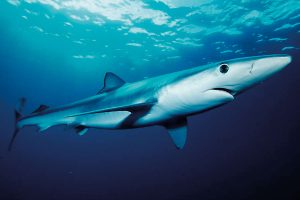
The skin of blue sharks (Prionace glauca) has antioxidant properties. This species is listed in the IUCN Red List as globally threatened, but in the Mediterranean its population is declining and it is currently classified as «critically endangered». Although recreational fishermen in Spain are not allowed to fish for it, they are also not required to report their catch. / Photo: Mark Conlin – MFNS
Although many species with bioactive potential in the Mediterranean are vulnerable to global change and are listed in international conventions for the protection of species, they are not legally protected. A recent study (Carreño & Lloret, in press) indicates that around 20 % of the fish and marine macroinvertebrate species documented in Cap de Creus have bioactive potential, with 20 % of them also having been classified as vulnerable. New management measures are needed to protect vulnerable species with bioactive potential, including monitoring their stocks, establishing new regulations, and creating new marine protected areas. It will also be important to carry out outreach activities aimed at fishermen and marine recreation businesses (diving, sailing, etc.), as well as with the general public, to raise awareness of the importance of protecting these spaces. Species with bioactive potential must be protected not only because they are valuable components of marine ecosystems, but also because they are a potential source of molecules with pharmacological properties that could be used to research new drugs for treating diseases such as cancer. In this sense, we recommend that the policy-makers responsible for marine ecosystems consider the bioactive potential of vulnerable species and consider new measures to protect them, particularly in marine reserves, which constitute a veritable «pharmacy of the sea».
Notes
[1]The databases considered were ScienceDirect, PubMed, PLOS ONE, and Google Scholar. We also reviewed «grey» literature studies (reports and other work not published in indexed journals) and research projects dealing with anthropogenic impacts, especially those from the PHAROS4MPAS project PHAROS4MPAS project, which compiles impacts on marine protected areas (MPAs) in the Mediterranean.
References
Alexander, M. T., & Wigart, R. C. (2013). Effect of motorized watercraft on summer nearshore turbidity at Lake Tahoe, California–Nevada. Lake and Reservoir Management, 29(4), 247– 56. https://doi.org/10.1080/10402381.2013.840704
Boero, F., Brotz, L., Gibbons, M., Piraino, S., & Zampardi, S. (2016). 3.10 Impacts and effects of ocean warming on jellyfish. In D. Laffoley & J. M. Baxter (Eds.), Explaining ocean warming: Causes, scale, effects and consequences (pp. 213–237). IUCN.
Bonin-Font, F., Lalucat, J., Oliver-Codina, G., Massot-Campos, M., Font, E. G., & Carrasco, P. L. N. (2018). Evaluating the impact of sewage discharges on the marine environment with a lightweight AUV. Marine Pollution Bulletin, 135, 714–722. https://doi.org/10.1016/J.MARPOLBUL.2018.07.071
Bordbar, L., Kapiris, K., Kalogirou, S., & Anastasopoulou, A. (2018). First evidence of ingested plastics by a high commercial shrimp species (Plesionika narval) in the eastern Mediterranean. Marine Pollution Bulletin, 136, 472–476. https://doi.org/10.1016/J.MARPOLBUL.2018.09.030
Bruton, M. N. (1985). The effects of suspensoids on fish. Hydrobiologia, 125(1), 221–241. https://doi.org/10.1007/BF00045937
Cabanellas-Reboredo, M., Vázquez-Luis, M., Mourre, B., Álvarez, E., Deudero, S., Amores, Á., Addis, P., Ballesteros, E., Barrajón, A., Coppa, S., García-March, J. R., Giacobbe, S., Casalduero, F. G., Hadjioannou, L., Jiménez-Gutiérrez, S. V., Katsanevakis, S., Kersting, D., Mačić, V., Mavrič, B., … Hendriks, I. E. (2019). Tracking a mass mortality outbreak of pen shell Pinna nobilis populations: A collaborative effort of scientists and citizens. Scientific Reports, 9(1), 13355. https://doi.org/10.1038/s41598-019-49808-4
Campos, F. V., Menezes, T. N., Malacarne, P. F., Costa, F. L. S., Naumann, G. B., Gomes, H. L., & Figueiredo, S. G. (2016). A review on the Scorpaena plumieri fish venom and its bioactive compounds. Journal of Venomous Animals and Toxins including Tropical Diseases, 22, 35. https://doi.org/10.1186/s40409-016-0090-7
Carreño, A., & Lloret, J. (en prensa). The vulnerability of fish and macroinvertebrate species with bioactive potential in a Mediterranean marine protected area. Aquatic Conservation: Marine and Freshwater Ecosystems.
Casoli, E., Nicoletti, L., Mastrantonio, G., Jona-Lasinio, G., Belluscio, A., & Ardizzone, G. D. (2017). Scuba diving damage on coralligenous builders: Bryozoan species as an indicator of stress. Ecological Indicators, 74, 441–450. https://doi.org/10.1016/J.ECOLIND.2016.12.005
Cheung, W. W. L., Pitcher, T. J., & Pauly, D. (2005). A fuzzy logic expert system to estimate intrinsic extinction vulnerabilities of marine fishes to fishing. Biological Conservation, 124(1), 97–111. https://doi.org/10.1016/j.biocon.2005.01.017
Codarin, A., Wysocki, L. E., Ladich, F., & Picciulin, M. (2009). Effects of ambient and boat noise on hearing and communication in three fish species living in a marine protected area (Miramare, Italy). Marine Pollution Bulletin, 58(12), 1880–1887. https://doi.org/10.1016/j.marpolbul.2009.07.011
Coro, G., Vilas, L. G., Magliozzi, C., Ellenbroek, A., Scarponi, P., & Pagano, P. (2018). Forecasting the ongoing invasion of Lagocephalus sceleratus in the Mediterranean Sea. Ecological Modelling, 371, 37–49. https://doi.org/10.1016/j.ecolmodel.2018.01.007
Derraik, J. G. (2002). The pollution of the marine environment by plastic debris: A review. Marine Pollution Bulletin, 44(9), 842–852. https://doi.org/10.1016/S0025-326X(02)00220-5
Erena, M., Domínguez, J. A., Aguado-Giménez, F., Soria, J., & García-Galiano, S. (2019). Monitoring coastal lagoon water quality through remote sensing: The Mar Menor as a case study. Water, 11(7), 1468. https://doi.org/10.3390/w11071468
Hendriks, I. E., Tenan, S., Tavecchia, G., Marbà, N., Jordà, G., Deudero, S., Álvarez, E., & Duarte, C. M. (2013). Boat anchoring impacts coastal populations of the pen shell, the largest bivalve in the Mediterranean. Biological Conservation, 160, 105–113. https://doi.org/10.1016/J.BIOCON.2013.01.012
Katsanevakis, S., Coll, M., Piroddi, C., Steenbeek, J., Ben Rais Lasram, F., Zenetos, A., & Cardoso, A. C. (2014). Invading the Mediterranean Sea: Biodiversity patterns shaped by human activities. Frontiers in Marine Science, 1, 32. https://doi.org/10.3389/fmars.2014.00032
Lloret, J., Biton-Porsmoguer, S., Carreño, A., Di Franco, A., Sahyoun, R., Melià, P., Claudet, J., Sève, C., Ligas, A., Belharet, M., Calò, A., Carbonara, P., Coll, M., Corrales, X., Lembo, G., Sartor, P., Bitetto, I., Vilas, D., Piroddi, C., … Font, T. (2019). Recreational and small-scale fisheries threaten vulnerable species in coastal and offshore Mediterranean waters. ICES Journal of Marine Science, 77(6), 2255-2264. https://doi.org/10.1093/icesjms/fsz071
Lloret, J., Garrote, A., Balasch, N., & Font, T. (2014). Estimating recreational fishing tackle loss in Mediterranean coastal areas: Potential impacts on wildlife. Aquatic Ecosystem Health & Management, 17(2), 179–185. https://doi.org/10.1080/14634988.2014.910070
Milazzo, M., Badalamenti, F., Ceccherelli, G., & Chemello, R. (2004). Boat anchoring on Posidonia oceanica beds in a marine protected area (Italy, western Mediterranean): Effect of anchor types in different anchoring stages. Journal of Experimental Marine Biology and Ecology, 299(1), 51–62. https://doi.org/10.1016/J.JEMBE.2003.09.003
Natalotto, A., Sureda, A., Maisano, M., Spanò, N., Mauceri, A., & Deudero, S. (2015). Biomarkers of environmental stress in gills of Pinna nobilis (Linnaeus 1758) from Balearic Island. Ecotoxicology and Environmental Safety, 122, 9–16. https://doi.org/10.1016/J.ECOENV.2015.06.035
Nieto, F. R., Cobos, E. J., Tejada, M. Á., Sánchez-Fernández, C., González-Cano, R., & Cendán, C. M. (2012). Tetrodotoxin (TTX) as a therapeutic agent for pain. Marine Drugs, 10(2), 281–305. https://doi.org/10.3390/md10020281
PharmaMar. (2020, 16 de marzo). PharmaMar anuncia resultados positivos de Aplidin® contra el coronavirus HCoV-229E. http://www.pmfarma.es/noticias/28280-pharmamar-anuncia-resultados-positivos-de-aplidin-contra-el-coronavirus-hcov-229e.html
Pipitone, C., Badalamenti, F., D’Anna, G., & Patti, B. (2000). Fish biomass increase after a four-year trawl ban in the Gulf of Castellammare (NW Sicily, Mediterranean Sea). Fisheries Research, 48(1), 23–30. https://doi.org/10.1016/S0165-7836(00)00114-4
Potera, C. (2007). Florida red tide brews up drug lead for cystic fibrosis. Science, 316(5831), 1561–1562. https://doi.org/10.1126/science.316.5831.1561
Simmons, T. L., Andrianasolo, E., McPhail, K., Flatt, P., & Gerwick, W. H. (2005). Marine natural products as anticancer drugs. Molecular Cancer Therapeutics, 4(2), 333–342. http://www.ncbi.nlm.nih.gov/pubmed/15713904
Trainer, V. L., & Hardy, F. J. (2015). Integrative monitoring of marine and freshwater harmful algae in washington state for public health protection. Toxins, 7(4), 1206–1234. https://doi.org/10.3390/toxins7041206
Uriz, M. J., Martin, D., Turon, X., Ballesteros, E., Hughes, R., & Acebal, C. (1991). An approach to the ecological significance of chemically mediated bioactivity in Mediterranean benthic communities. Marine Ecology Progress Series, 70(2), 175–188. https://doi.org/10.3354/meps070175
Verdura, J., Linares, C., Ballesteros, E., Coma, R., Uriz, M. J., Bensoussan, N., & Cebrian, E. (2019). Biodiversity loss in a Mediterranean ecosystem due to an extreme warming event unveils the role of an engineering gorgonian species. Scientific Reports, 9, 5911. https://doi.org/10.1038/s41598-019-41929-0
Zahn, R. K., Zahn, G., Müller, W. E. G., Müller, I., Beyer, R., Müller-berger, U., Kurelec, B., Rijavec, M., & Britvić, S. (1977). Consequences of detergent pollution of the sea: Effects on regenerating sponge cubes of Geodia cydonium. Science of The Total Environment, 8(2), 109–151. https://doi.org/10.1016/0048-9697(77)90072-9




